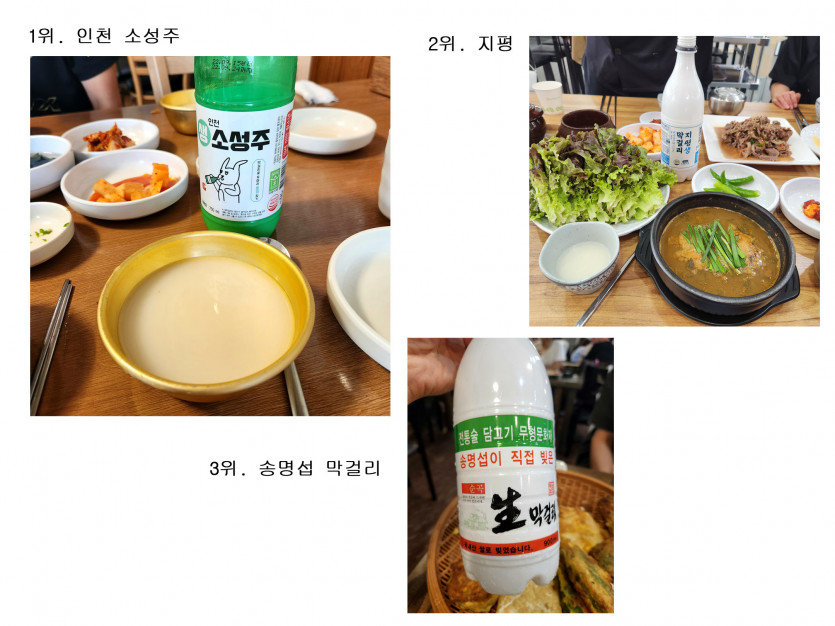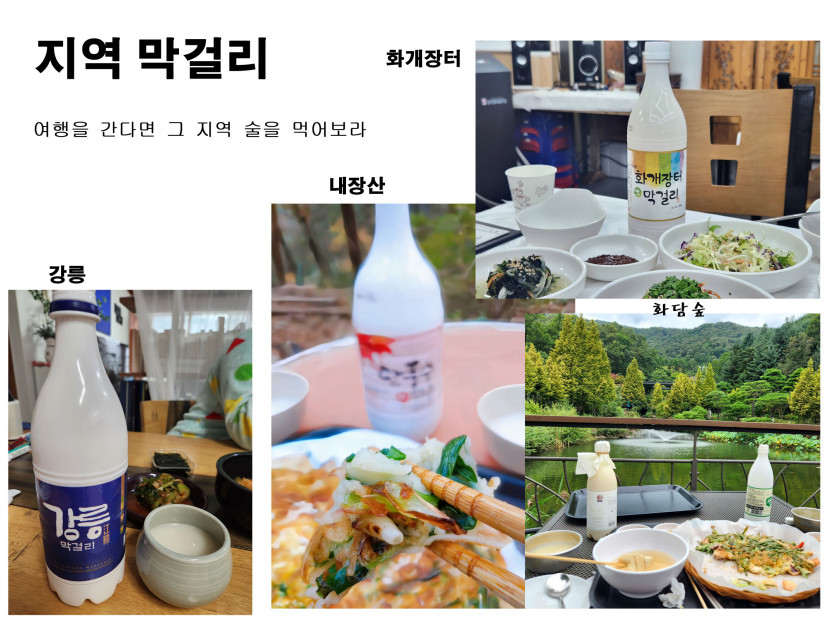Makgeolli: Brewing Tradition and My Top 3 Must-Try Picks
페이지 정보
본문
While I've never brewed makgeolli myself, a warm, heartfelt memory of homemade alcohol remains tucked away in my childhood recollections. I vividly recall my mother brewing alcohol for my father, who enjoyed a drink, as winter began to fade. Around the time the scent of shepherd's purse filled the air, a large earthenware pot sat in the warmest spot of the room, gently covered by a blanket. My mother would carefully open the lid once a day to check on it, and I clearly remember her face flushing red each time she tasted the makgeolli. She was, by the way, someone who would turn red after just a sip of soju.
막걸리를 직접 빚어본 적은 없지만, 어린 시절 기억 한 켠에 따뜻한 정성이 담긴 술이 있다. 술을 좋아하시던 아버지를 위해 어머니가 겨울 끝자락에 술을 담그시던 모습. 냉이 향이 퍼질 무렵, 방 안 아랫목에는 커다란 항아리가 자리했고, 이불로 곱게 덮여 있었다. 어머니는 하루에 한 번씩 조심스레 뚜껑을 열어 안을 들여다보셨고, 막걸리 맛을 보실 때마다 얼굴이 붉게 상기되던 장면이 선명하다. 참고로, 어머니는 소주 한 모금에도 얼굴이 빨개지는 체질이셨다.
How to Make Traditional Makgeolli
Ingredients:
2kg Rice
200g Nuruk (Korean fermentation starter)
Yeast (or malted barley)
Instructions:
Wash the rice several times until the water runs clear, then soak it in warm water for about an hour.
Drain the water from the rice, place it in a steamer, and steam it over high heat for 40 minutes, then let it steam on low heat for another 10 minutes.
Spread the cooked rice (godubap) thinly to cool. In the past, people used to spread it on a flat platform in the yard to let it air out.
Soak the nuruk and yeast in water beforehand. (Add a little sugar to the yeast to aid fermentation.)
In a large bowl, combine the godubap, nuruk, yeast, and 2 liters of water, mixing well until the rice grains are thoroughly separated.
Transfer the mixture to an earthenware pot, press it down flat, and ferment at around 24-25 degrees Celsius. Traditionally, a blanket was used to maintain the temperature at the araetmok.
Stir once a day to check the fermentation progress. If successfully fermenting, bubbles will form, and you'll hear a "boggle-boggle" sound.
Once fermentation is complete, the clear liquid at the top becomes dongdongju, and the remaining rice grains are pressed to extract the makgeolli.
My Top 3 Makgeolli Recommendations
Soseongju (Incheon) Made by a brewery that still adheres to traditional methods, this makgeolli is known not only for its taste but also for its alleged anti-cancer properties. You can feel the deep flavor and sincere effort.
Jipyeong Makgeolli (Yangpyeong) This traditional brewery dates back to 1925. Its long history is evident, with the building itself designated as a modern cultural heritage site. Its subtle taste and aroma are captivating.
Song Myeong-seop Makgeolli A fresh (saeng) makgeolli brewed with rice cultivated directly by the maker. It's characterized by its clean and wholesome taste, free of additives. It might be less appealing to those who prefer sweeter options.
There's nothing quite as delicious as fresh saeng makgeolli enjoyed locally during a trip. If you go to Pocheon, I highly recommend Pocheon I-dong Saeng Makgeolli, and in Songnisan, try Danpungju at a pajeon (savory pancake) restaurant halfway up the mountain. The comfort a glass of makgeolli offers after a mountain hike is truly special.
While excessive drinking is harmful to health, tasting local specialty alcoholic beverages during travel adds vibrancy to life. Sometimes, that single glass might best encapsulate the warmth of that region.
전통 막걸리 만드는 법 꼭 먹어봐야할 TOP 3
막걸리를 직접 빚어본 적은 없지만, 어린 시절 기억 한 켠에 따뜻한 정성이 담긴 술이 있다.
술을 좋아하시던 아버지를 위해 어머니가 겨울 끝자락에 술을 담그시던 모습. 냉이 향이 퍼질 무렵, 방 안 아랫목에는 커다란 항아리가 자리했고, 이불로 곱게 덮여 있었다.
어머니는 하루에 한 번씩 조심스레 뚜껑을 열어 안을 들여다보셨고, 막걸리 맛을 보실 때마다 얼굴이 붉게 상기되던 장면이 선명하다.
참고로, 어머니는 소주 한 모금에도 얼굴이 빨개지는 체질이셨다.
막걸리 만드는 법
재료
쌀 2kg
누룩 200g
효모 (또는 엿기름)
1. 쌀은 맑은 물이 나올 때까지 여러 번 씻은 후, 한 시간 정도 따뜻한 물에 불린다.
2. 물기를 뺀 쌀을 찜통에 넣고 센 불에서 40분간 찐 뒤, 약한 불로 10분 뜸을 들인다.
3. 완성된 고두밥을 넓게 펴 식힌다. 예전엔 마당 평상에 펼쳐 바람을 쐬었다.
4. 누룩과 효모는 미리 물에 불려 준비한다. (효모에는 설탕을 약간 섞어 발효를 도와준다)
5. 큰 그릇에 고두밥, 누룩, 효모, 물 2리터를 넣고 밥알이 잘 풀리도록 고루 섞는다.
6. 항아리에 담고 평평하게 눌러 24~25도 정도로 발효시킨다. 예전엔 아랫목에 이불을 덮어 온도를 유지했다.
7. 하루에 한 번 저어주며 발효 상태를 확인한다. 성공적으로 발효되면 기포가 생기며 ‘보글보글’ 소리가 난다.
8. 발효가 완료되면 윗부분의 맑은 술은 ‘동동주’가 되고, 남은 밥알을 눌러 짜내면 막걸리가 완성된다.
내가 추천하는 막걸리 Top 3
1. 소성주 (인천)
아직도 전통방식을 고수하는 양조장에서 만든 이 술은 맛뿐만 아니라 항암 효능이 있다고도 알려졌다. 깊은 맛과 정성이 느껴진다.
2. 지평 막걸리 (양평)
1925년부터 이어져 온 전통 양조장. 건물 자체가 근대문화유산으로 지정되어 있을 만큼 오랜 역사를 자랑한다. 은은한 맛과 향이 매력적이다.
3. 송명섭 막걸리
직접 농사지은 쌀로 빚어내는 생 막걸리. 첨가물이 들어가지 않아 담백하고 건강한 맛이 특징이다. 단맛을 선호하는 이들에겐 조금 덜 맞을 수 있다.
여행 중 현지에서 마시는 신선한 생 막걸리만큼 맛있는 것도 없다. 포천에 가면 꼭 포천 이동 생막걸리를, 속리산에서는 산 중턱의 파전집에서 단풍주를 추천한다. 산을 오른 후 한 잔의 막걸리가 주는 위로는 참 특별하다.
과음은 건강에 해롭지만, 여행 중 지역 특산주를 맛보는 일은 삶에 활력을 더해준다. 때로는 그 한 잔이 그 지역의 온기를 가장 잘 담아내는 지도 모른다.
#Makgeolli #KoreanRiceWine #TraditionalBrewing #HomemadeAlcohol #KoreanCulture #FermentedDrinks #KoreanFood #AlcoholTrends #MustTryKoreanDrinks #KoreanTravel #LocalSpecialty #BrewingGuide #KimchiPairing #TasteofKorea #HeritageDrink #Soseongju #JipyeongMakgeolli #SongMyeongseopMakgeolli #MakgeolliRecipe #DrinkLocal
댓글목록
등록된 댓글이 없습니다.
 홈
홈




